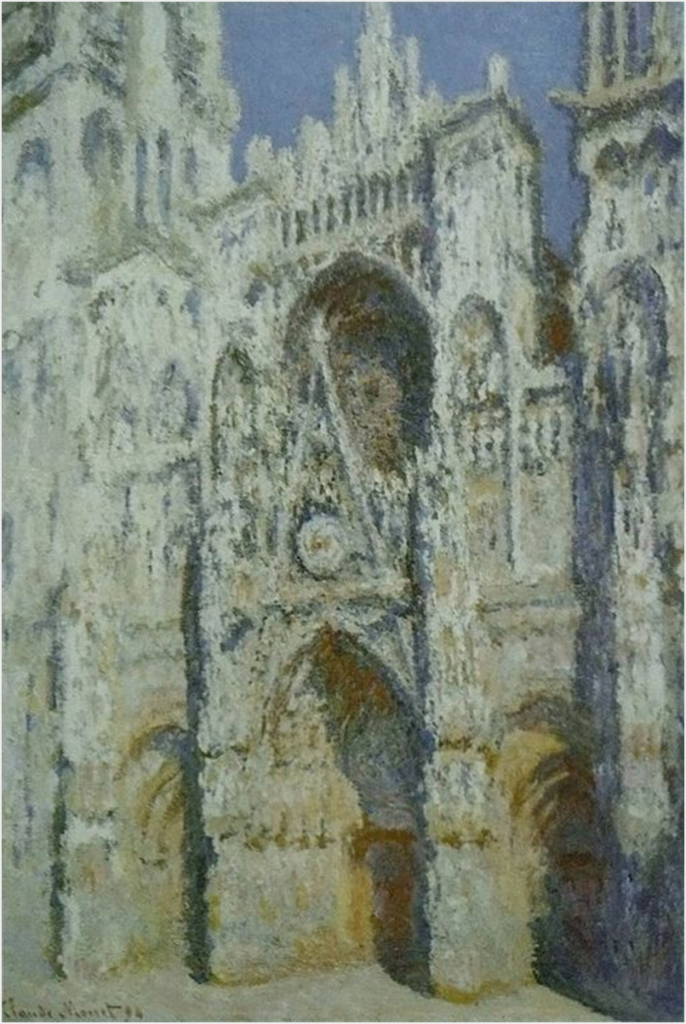1. Nymphéas Bleus (Blue Water Lilies) – 1916-1919

This artwork was created by Monet in his last years, just as his artistic career was beginning to flourish. Claude Monet purchased a large home in the little hamlet of Giverny as soon as he began making a significant amount of money. The house was on a large piece of property, and Monet devoted many hours to creating the most exquisite gardens. These gardens are now one of France’s most well-known tourist destinations.
A stunning lily pond in Claude Monet’s garden was created by him. For more than 30 years, his beloved lily pond served as his source of creative inspiration. In actuality, Claude Monet painted his water lily pond in more than 250 different pieces.
The water lily’s botanical name is Nymphaea. There is no horizon or sky in Nymphéas Bleus, this specific artwork. The lily pond is Claude Monet’s primary main focus. He wants to get a close-up of his favorite pond while also creating the impression of an infinitely large area.
2. London, Houses of Parliament. The Sun Shining through the Fog (1900)

Famous Claude Monet Paintings in the Musee D Orsay
Claude Monet spent the autumn of 1899, the early months of 1900, and 1901 in London and produced a number of oil paintings that included the Westminster Palace and the Houses of Parliament.
These pictures were created from the same vantage point, which was a terrace at St. Thomas’ Hospital with views of the Thames. Monet repeatedly photographed the same scene. He painted the scene many times during the day and in various weather situations, however, to capture the shifting hues and shadows.
These paintings weren’t completed by Monet in London. He carried the incomplete pieces of art back to his French studio to finish.
I cannot give you a single painting of London, he wrote to his art dealer Durand-Ruel. Since none of them are done, I have them all in front of me. I’ll complete them all at once.
Monet finished this series in 1903, three years later. This artwork and 36 others were initially shown at Durand-exhibition Ruel’s in Paris in 1904. They were very popular, and his artwork was in high demand!
3. Gare Saint-Lazare (Saint-Lazare train station) 1877

Famous Claude Monet Paintings in the Musee D Orsay
Between 1853 and 1870, Georges-Eugène Haussmann put a lot of effort into modernizing and updating Paris. For this massive urban redevelopment project, Haussmann built opulent buildings that stood side by side on spacious, tree-lined boulevards. He also supervised the building of magnificent parks, cutting-edge roads, and train stations for the French capital. One of the places visited was the sumptuous Saint Lazare.
Unknown painter Claude Monet traveled to Paris from Argenteuil, a rural community close to Paris where he resided with his family, through this railway station.
Claude Monet’s Fascination with the Industrialization & Modernization of the French Capital
This railway station captured Monet’s attention. It represented to him the whole essence of modernity and industrialization taking place all around Paris and France.
He ultimately produced twelve paintings of this station while renting an art studio close to the Gare Saint Lazare. He depicts the trains themselves, the bustling and packed platforms, and the clouds of steam that the trains emit in these paintings.
Claude Monet displayed a few of these pieces during the third Impressionist exhibition in 1877. The general public and critics of art were baffled by Monet’s choice to paint the station’s less appealing side. He painted the staff, the crowded train station, the smoke in the train shed, the billowing clouds of steam, and the smoke. Monet had no inclination to paint this train station outside the entrance, despite the fact that it was stunning and impressive.
The paintings of the Saint-Lazare Train Station are among his most well-known and important works of art, despite the fact that they were first poorly received when they were first shown. The intensive industrialization that was taking place in Paris throughout the 19th century is well captured in these works of art.
4. Poppy Field (Coquelicots), 1873

Famous Claude Monet Paintings in the Musee D Orsay
Claude Monet relocated to the little village of Argenteuil in 1871 after coming back to France from England. He stayed there until 1878. Since Monet was finally starting to sell his works via his art dealer Paul Durand-Ruel, these were Monet’s fruitful years. Monet loved being in the country, and the views of the open countryside were a continual source of creative inspiration for him. He would set up his easel outdoors and paint there.
On a bright, sunny day, Monet depicts a young lady walking through the poppies fields with a kid while wearing a sunshade umbrella. They are most likely his son Jean and his first wife Camille. Monet exhibited this painting for the first time during the first Impressionist exhibition in 1874.
5. Rouen Cathedral (1893)

Famous Monet Paintings in the Musee D Orsay










Leave a reply